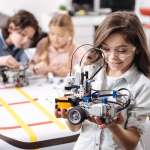It’s no secret that the COVID-19 pandemic has caused a lot of disruptions to our children’s education, and this is especially true for our early learners. A preschool is a place for young children to learn, explore, and grow. It is solely based on play and social interaction, which are skills that are an essential part of every child’s development. If you were the parent of a 3 or 4-year-old at the height of the coronavirus pandemic, you were likely faced with the impossible decision of whether or not to send your little one to school if daycares in your area were not affected by closures.
Looking back on the last couple of years compared to the 2022 school year, COVID-19 policies are changing as the CDC gathers more data about the virus, including how the infection is spread and how it affects young children. School districts are making their own decisions on how to best protect children based on the COVID-19 data in their area.
In this article, we will discuss how the 2022-2023 school year may look, especially for those starting pre-k. Plus, you can take a look back on what things were like in the past few years in comparison.
COVID Protocols for the 2022 School Year

Scientists say that COVID-19 deaths are on the decline, but cases are still rising in many areas across the globe. Many experts are advising that eligible individuals get vaccinated and boosted. Recently, the FDA authorized vaccines in children aged between 6 months and 4 years old, which will be a helpful factor in decreasing infection in preschools in America in the new school year. Though scientists are making great strides in combating the virus, it is still very prominent in America and many still consider it dangerous.
There has been a decline in enrollment, however, in childcare centers due to the COVID-19 pandemic. Parents are concerned about sending their young children to school because of the coronavirus and the risk to their health. California is a good example of an area where parents are noticing their little ones struggle to learn in a group setting because they missed out on that social exposure. Children who were 3 when the coronavirus pandemic first began were unable to go to preschool, and early childhood professionals are noticing the impact on early learning and emotional development.
With an overall decline in COVID-19 cases and deaths and thanks to the success of the vaccines, many schools are choosing to not make COVID-19 a huge part of their syllabus or decision making surrounding health. Masks are not being mandated, but in most schools, the decision on mask wearing is left up to the family of the child. You will notice that these policies change from state to state as well as between school districts.
7 STEM Careers Kids Can Explore
The STEM (science, technology, engineering, and math) field is growing every day, with new and interesting career paths emerging that weren't even a possibility a few years ago. Careers in the STEM field are some of the fastest-growing occupations in the country and feature amazing growth and salary potential. Here are a few of the most exciting STEM careers kids can explore. Read More
COVID Protocols in Previous Years

Public schools have gone through a lot in the past couple of years due to the COVID-19 pandemic. This is especially true for child-care providers and daycare centers. Many schools went through closures when the pandemic began. While this meant virtual learning or homeschooling for school-aged children, it wasn’t the same for preschoolers. The younger age group of 4-year-olds and under doesn’t have an academic-based curriculum. Instead, they learn through play and socialization. This means that younger children were some of the worst affected developmentally by the pandemic.
As early child care centers and schools reopened, several protocols were put in place to protect the students and staff from infection. This included increased cleaning and sanitation, social distancing when able, and the use of masks. Lots of preschools would have been careful to sanitize toys and games after long periods of use. Since the CDC has now changed its guidelines, we will likely see much more relaxed health safety protocols.
This great reference includes statistics and information about early childhood education during the pandemic.
Will Parents Be More Involved in Preschool Life This Year?

A big concern among parents and caregivers is the impact on child development. Losing out on quality time with their peers can negatively affect a child’s emotional development. Hence, it was very difficult for all parties during the peak of the pandemic which resulted in school closures. Taking care of your little one’s mental health can be just as important as taking care of their physical health. Social interaction is most important in the pre-k stage, and childcare providers are doing their best to provide high-quality education that fosters their social skills.
Parents are usually a big part of that. But during the pandemic, some preschools would have had to put social distancing measures in place which would have restricted parents from helping their child with the initial settling in period. Now that those legal restrictions aren’t in place, parents should be able to be more involved with this initial period if the preschool in question doesn’t have any social distancing measures in place.
Parents are also more involved in the curriculum now as well in many schools. They can go to school events and participate in important ceremonies in person, rather than virtually. This will hopefully be great for building self-esteem in preschoolers, which is an important part of their emotional development.
The Takeaway
While our country is not out of the woods yet, things look promising. There are several things that you can do at home to help stop the spread. This includes regular testing if you travel, mask-wearing in certain settings like doctor’s offices or large indoor crowds, getting vaccinated, and simple things like handwashing and carrying hand sanitizer with you when you are out and about. We may be amid a pandemic, but life and education continues to go on!



